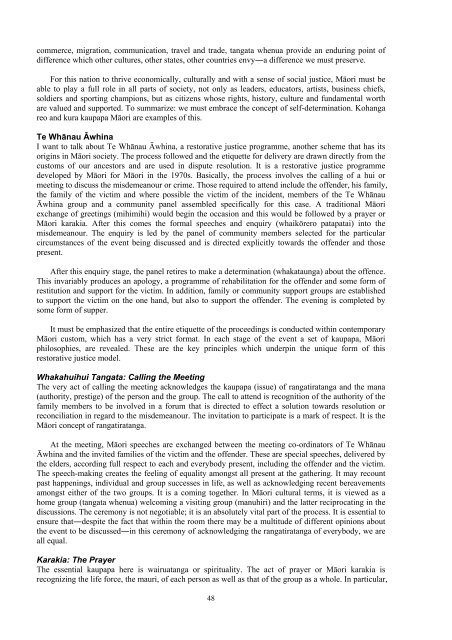traditional knowledge conference 2008 te tatau pounamu
traditional knowledge conference 2008 te tatau pounamu
traditional knowledge conference 2008 te tatau pounamu
Create successful ePaper yourself
Turn your PDF publications into a flip-book with our unique Google optimized e-Paper software.
commerce, migration, communication, travel and trade, tangata whenua provide an enduring point ofdifference which other cultures, other sta<strong>te</strong>s, other countries envy―a difference we must preserve.For this nation to thrive economically, culturally and with a sense of social justice, Māori must beable to play a full role in all parts of society, not only as leaders, educators, artists, business chiefs,soldiers and sporting champions, but as citizens whose rights, history, culture and fundamental worthare valued and suppor<strong>te</strong>d. To summarize: we must embrace the concept of self-de<strong>te</strong>rmination. Kohangareo and kura kaupapa Māori are examples of this.Te Whānau ĀwhinaI want to talk about Te Whānau Āwhina, a restorative justice programme, another scheme that has itsorigins in Māori society. The process followed and the etiquet<strong>te</strong> for delivery are drawn directly from thecustoms of our ancestors and are used in dispu<strong>te</strong> resolution. It is a restorative justice programmedeveloped by Māori for Māori in the 1970s. Basically, the process involves the calling of a hui ormeeting to discuss the misdemeanour or crime. Those required to at<strong>te</strong>nd include the offender, his family,the family of the victim and where possible the victim of the incident, members of the Te WhānauĀwhina group and a community panel assembled specifically for this case. A <strong>traditional</strong> Māoriexchange of greetings (mihimihi) would begin the occasion and this would be followed by a prayer orMāori karakia. Af<strong>te</strong>r this comes the formal speeches and enquiry (whaikōrero patapatai) into themisdemeanour. The enquiry is led by the panel of community members selec<strong>te</strong>d for the particularcircumstances of the event being discussed and is direc<strong>te</strong>d explicitly towards the offender and thosepresent.Af<strong>te</strong>r this enquiry stage, the panel retires to make a de<strong>te</strong>rmination (whakataunga) about the offence.This invariably produces an apology, a programme of rehabilitation for the offender and some form ofrestitution and support for the victim. In addition, family or community support groups are establishedto support the victim on the one hand, but also to support the offender. The evening is comple<strong>te</strong>d bysome form of supper.It must be emphasized that the entire etiquet<strong>te</strong> of the proceedings is conduc<strong>te</strong>d within con<strong>te</strong>mporaryMāori custom, which has a very strict format. In each stage of the event a set of kaupapa, Māoriphilosophies, are revealed. These are the key principles which underpin the unique form of thisrestorative justice model.Whakahuihui Tangata: Calling the MeetingThe very act of calling the meeting ac<strong>knowledge</strong>s the kaupapa (issue) of rangatiratanga and the mana(authority, prestige) of the person and the group. The call to at<strong>te</strong>nd is recognition of the authority of thefamily members to be involved in a forum that is direc<strong>te</strong>d to effect a solution towards resolution orreconciliation in regard to the misdemeanour. The invitation to participa<strong>te</strong> is a mark of respect. It is theMāori concept of rangatiratanga.At the meeting, Māori speeches are exchanged between the meeting co-ordinators of Te WhānauĀwhina and the invi<strong>te</strong>d families of the victim and the offender. These are special speeches, delivered bythe elders, according full respect to each and everybody present, including the offender and the victim.The speech-making crea<strong>te</strong>s the feeling of equality amongst all present at the gathering. It may recountpast happenings, individual and group successes in life, as well as acknowledging recent bereavementsamongst either of the two groups. It is a coming together. In Māori cultural <strong>te</strong>rms, it is viewed as ahome group (tangata whenua) welcoming a visiting group (manuhiri) and the lat<strong>te</strong>r reciprocating in thediscussions. The ceremony is not negotiable; it is an absolu<strong>te</strong>ly vital part of the process. It is essential toensure that―despi<strong>te</strong> the fact that within the room there may be a multitude of different opinions aboutthe event to be discussed―in this ceremony of acknowledging the rangatiratanga of everybody, we areall equal.Karakia: The PrayerThe essential kaupapa here is wairuatanga or spirituality. The act of prayer or Māori karakia isrecognizing the life force, the mauri, of each person as well as that of the group as a whole. In particular,48
















